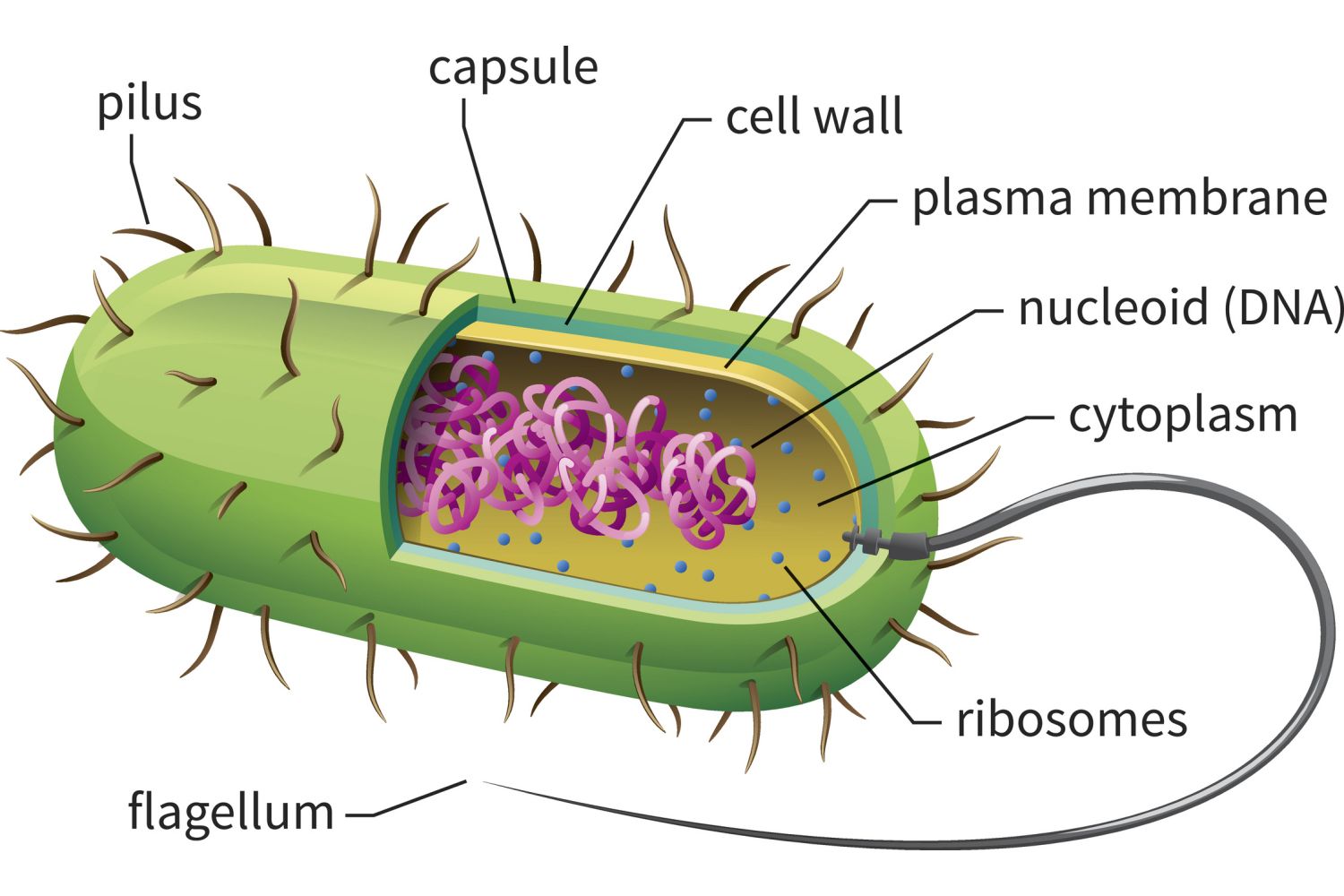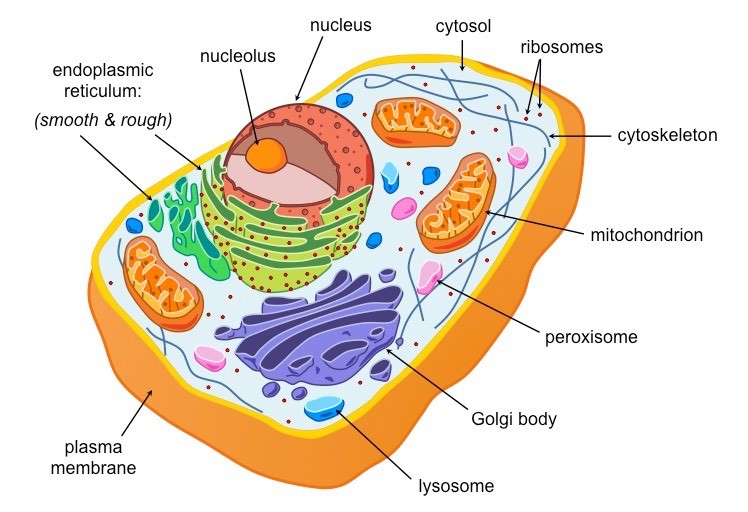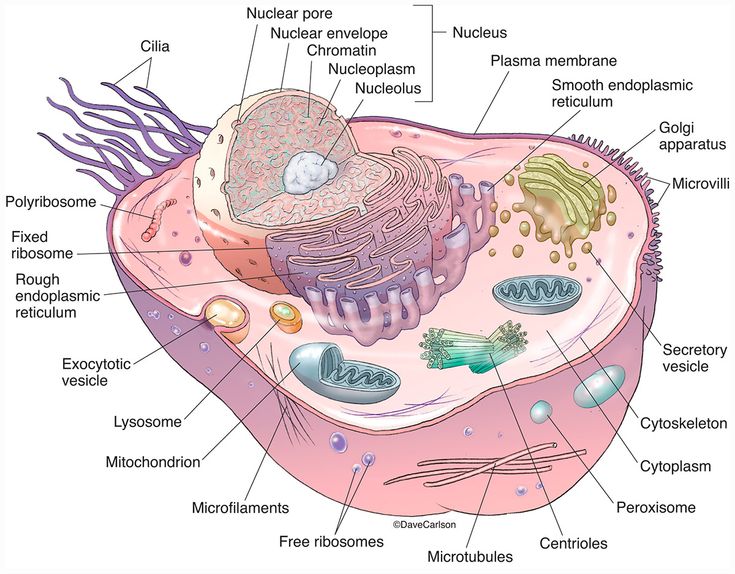The study of cell structure and function is known as cell biology, and it is based on the idea that the cell is the most basic unit of life. Concentrating on the cell allows for a more in-depth understanding of the tissues and organisms that cells make up. Some species have only one cell, whereas others have large cooperating groups of cells. Cell biology is concerned with the structure and function of a cell, from the most basic traits shared by all cells to the unique, highly complex tasks exclusive to specialized cells.
Definition of a Cell
A cell is the smallest, most fundamental unit of life, responsible for all of life’s processes.
All living things are made up of cells, which are the structural, functional, and biological components. A cell has the ability to duplicate itself on its own. As a result, they are referred to as the “building blocks of life.”
A fluid termed cytoplasm is contained within each cell and is surrounded by a membrane. Proteins, nucleic acids, and lipids are among the biomolecules found in the cytoplasm. Cell organelles, which are suspended in the cytoplasm, are also present.
Cells are the building blocks of all living things. They might be made up of a single cell (unicellular) or a large number of cells(multicellular). Mycoplasmas are the smallest cells known. Cells are intricate, and their constituents perform a variety of tasks in an organism.
They come in a variety of forms and sizes, similar to building bricks. Our bodies are made up of cells of various sizes and shapes.
Every living thing has cells, which are the most basic level of organization. The number of cells varies from organism to organism. When compared to microorganisms, humans have a higher number of cells.
Cell organelles perform specialized activities in order for cells to carry out life processes. Each organelle has its own structure. The organisms’ hereditary material is also present in the cells.
Cells’ Discovery
The discovery of cells is one of science’s most significant achievements. It teaches us that all organisms are made up of cells, which aid in the execution of numerous life processes. The structure and functions of cells aided us in gaining a deeper understanding of life.
In 1665, Robert Hooke discovered the cell. Under a compound microscope, Robert Hooke examined a piece of bottle cork and found minuscule formations that reminded him of small rooms.
The 1830s could be regarded the beginning of this discipline. Despite the fact that scientists had been using microscopes for centuries, they didn’t always know what they were looking at. In 1665, Robert Hooke observed plant-cell walls in slices of cork, which was quickly followed by Antonie van Leeuwenhoek’s first descriptions of live cells with visibly moving elements.
In the 1830s, two colleagues — Schleiden, who studied plant cells, and Schwann, who studied animal cells first — provided the first precise definition of the cell. All living entities, both simple and complex, are made up of one or more cells, and the cell is the structural and functional unit of life, according to their definition — a concept that became known as cell theory.
Scientists were able to detect more and more interior information within cells as microscopes and staining techniques advanced over the nineteenth and twentieth centuries. Van Leeuwenhoek’s microscopes magnified specimens by a factor of a few hundred. Today’s high-powered electron microscopes can magnify specimens by more than a million times and reveal organelle shapes on the micrometer scale and below.
A sequence of photos can be combined with confocal microscopy, allowing researchers to create detailed three-dimensional reconstructions of cells. These advancements in imaging techniques have allowed us to gain a deeper understanding of the amazing intricacy of cells and the structures they generate.
Various Cell Types
Cells are comparable to factories in that they have various workers and departments working toward a shared goal. Distinct types of cells have different purposes. There are two types of cells:
Prokaryotic Cells
- There is no nucleus in prokaryotic cells. Rather, some prokaryotes, such as bacteria, have an area within the cell where the genetic material is free to move around. The nucleoid is the name for this area.
- They are all bacteria with only one cell. Archaea, bacteria, and cyanobacteria are examples.
- The diameter of the cells varies between 0.1 and 0.5 m.
- DNA or RNA can be used as hereditary material.
- Binary fission, an asexual reproductive method, is used by most prokaryotes.
- They are also known to use conjugation, which is commonly thought of as the bacterial counterpart of sexual reproduction.

Eukaryotic Cell
- A true nucleus distinguishes eukaryotic cells.
- The diameter of the cells varies between 10 and 100 m.
- Plants, fungi, protozoans, and animals all fall into this broad category.
- The plasma membrane is in charge of monitoring nutrition and electrolyte movement in and out of the cells. Cell-to-cell communication is also handled by it.
- They reproduce both sexually and asexually.
- Plant and animal cells have various distinct characteristics. Plant cells, for example, have chloroplasts, central vacuoles, and other plastids, while animal cells do not.

Structure of a Cell
Individual components with specialized activities that are required to carry out life’s operations make up the cell structure. The cell wall, cell membrane, cytoplasm, nucleus, and cell organelles are among these components.
Cell Membrane
- The cell membrane keeps the cell alive and protects it. It regulates the flow of chemicals into and out of cells. It acts as a barrier between the cell and the outside world. The cell membrane is found in every cell.
- The cell membrane is the cell’s outer coat, which encloses all other organelles such as the cytoplasm and nucleus. The plasma membrane is another name for it.
- It is a porous membrane (one with pores) that allows selected substances to pass into and out of the cell.
- Aside from that, the cell membrane guards the cellular component against damage and leakage.
- It creates a barrier between two cells as well as between the cell and its environment.
- Because plants are stationary, their cell structures have evolved to shield them from the elements. This function is reinforced by the cell wall.
Cell Wall
- The most visible element of the plant’s cell structure is the cell wall. It consists of three components: cellulose, hemicellulose, and pectin.
- Plant cells are the only ones that have a cell wall. The plasma membrane and other cellular components are protected by it. Plant cells’ cell walls are also the outermost layer.
- It’s a stiff and rigid structure that surrounds the cell membrane.
- It gives the cells structure and support while also shielding them from mechanical shocks and damage.
Cytoplasm
- Inside the cell membrane, the cytoplasm is a thick, transparent, jelly-like fluid.
- The cytoplasm is where the majority of a cell’s chemical reactions take place.
- In this cytoplasm, cell organelles such as the endoplasmic reticulum, vacuoles, mitochondria, and ribosomes are suspended.
Nucleus
- The cell’s hereditary material, DNA, is housed in the nucleus.
- It provides messages to the cells telling them to divide, grow, and die.
- The nuclear envelope isolates the DNA from the rest of the cell and surrounds the nucleus.
- The nucleus protects the DNA and is an important part of the cell structure of plants.
The Functions of Cell Organelles
- Nucleolus
Ribosome synthesis takes place in the nucleolus. It also has a role in regulating cellular activity and reproduction. - Nuclear Membrane
By providing a barrier between the nucleus and other cell organelles, the nuclear membrane protects the nucleus. - Chromosomes
Chromosomes are important in establishing an individual’s gender. There are 23 pairs of chromosomes in each human cell. - Endoplasmic reticulum (ER)
The endoplasmic reticulum is responsible for transporting materials throughout the cell. It is essential for glucose metabolism, lipid synthesis, steroid synthesis, and protein synthesis. - Golgi Bodies
The cell’s post office is the Golgi body, which is important in the transportation of materials within the cell. - Ribosome
Ribosomes are the cell’s protein synthesizers. - Mitochondria
The mitochondrion is known as “the cell’s powerhouse.” It gets its name from the fact that it produces ATP, the cell’s energy currency. - Lysosomes
Lysosomes help in cell renewal and protect the cell by engulfing foreign substances that enter the cell. As a result, they’re referred to as the cell’s suicide bags. - Chloroplast
The primary organelles for photosynthesis are chloroplasts. Chlorophyll is a pigment found in it. - Vacuoles
Food, water, and other waste items are stored in vacuoles in the cell.
Molecules of Cell
A membrane surrounds a cell, which contains a unique collection of chemicals. The ability to develop and reproduce is provided by these chemicals. Cell division and cell expansion are the two processes in the overall process of cellular reproduction. During cell proliferation, the cell preferentially transports particular chemicals from its environment via its cell membrane.
Once within the cell, these molecules are subjected to the action of enzymes, which are highly specialized, big, intricately folded molecules. By attaching to ingested molecules and controlling the rate at which they are chemically changed, enzymes operate as catalysts. The molecules become more valuable to the cell as a result of these chemical changes. Catalysts, unlike ingested molecules, are not chemically altered during the reaction, allowing one catalyst to regulate a specific chemical reaction in many molecules.
Chains of reactions are created by biological catalysts. To put it another way, a molecule that has been chemically altered by one catalyst becomes the starting material, or substrate, for a subsequent catalyst, and so on. Catalysts utilize small chemicals supplied into the cell from outside to build progressively complicated reaction products in this way.
These products are used in cell development and genetic material replication. The cell divides into two daughter cells once the genetic material has been duplicated and there are enough molecules to sustain cell division. Each parent cell can give rise to millions of daughter cells over the course of many such cycles of cell growth and division, turning huge amounts of inanimate materials into biologically active molecules.
Cell Theory
Theodor Schwann, Matthias Schleiden, and Rudolf Virchow, all German scientists, proposed the Cell Theory. According to the cell theory,
- Cells make up every living thing on the planet.
- The simplest unit of life is the cell.
- Pre-existing cells give rise to all cells.
In the end, a modern version of the cell theory was developed, which included the following postulates:
- Within the cells, energy flows.
- From one cell to the next, genetic information is passed on.
- All of the cells have the same chemical composition.
Cell biology is divided into various subfields. The study of cell energy and the molecular systems that enable cell metabolism is one such example. Because cells are machines in and of themselves, the study of cell energy intersects with the study of how energy initially formed billions of years ago in primordial cells. Another branch of cell biology is cell genetics, which is closely linked to the proteins that control the transfer of genetic information from the nucleus to the cytoplasm.
Another subfield focuses on the structure of subcellular compartments, which are cell components. The extra subfield of cell biology, which is concerned with cell communication and signaling and focuses on the messages that cells give to and receive from other cells and themselves.
Finally, there is the subfield that is largely concerned with the cell cycle, which is the rotation of phases that begins and ends with cell division and is focused on various stages of growth and DNA replication. As our ability to investigate cells in more complicated ways grows, many cell biologists work at the intersection of two or more of these subfields.
The recent emergence of systems biology has impacted many biological disciplines, in line with the increasing interdisciplinary study. It is a methodology that encourages the analysis of living systems in the context of other systems, and it is a methodology that encourages the analysis of living systems within the context of other systems.
Systems biology has made it possible to ask and answer increasingly complicated issues in cell biology, such as the interrelationships of gene regulatory networks, evolutionary links between genomes, and the interactions between intracellular signaling networks. Finally, the larger a lens we apply to our cell biology discoveries, the more likely we are to unravel the intricacies of all biological systems, large and small.
Functions of Cell
A cell is responsible for many processes that are necessary for an organism’s growth and development. The following are some of the most important functions of a cell:
1. Provides Structure and Support
Cells are the building blocks of all living things. They are the structural foundation of all living things. The key components that offer support and structure to the organism are the cell wall and the cell membrane. The skin, for example, is composed of a vast number of cells. The cells that make up the xylem in vascular plants provide structural support to the plants.
2. Facilitate Growth Mitosis
Mitosis is the division of a parent cell into two daughter cells. As a result, the cells multiply and aid in the growth of the organism.
3. Allows Substances to be Transported
The cells import various nutrients in order to carry out various chemical activities within the cells. Active and passive transport removes the waste produced by chemical reactions from the cells. Along the concentration gradient, small molecules like oxygen, carbon dioxide, and ethanol diffuse across the cell membrane. This is referred to as passive transportation. The bigger molecules are transported across the cell membrane by active transport, which requires a lot of energy from the cells.
4. Production of Energy
To carry out numerous chemical operations, cells require energy. Cells generate this energy through a process known as photosynthesis in plants and respiration in animals.
5. Aids in Reproduction
Mitosis and meiosis are two processes that contribute in cell reproduction. Mitosis is the asexual reproduction process in which the parent cell divides into daughter cells. Meiosis results in genetic differences between the daughter cells and the parent cells.
As a result, we can see why cells are referred to as the structural and functional unit of life. This is due to the fact that they provide structure to organisms and conduct a variety of tasks that are required to carry out life’s processes.
